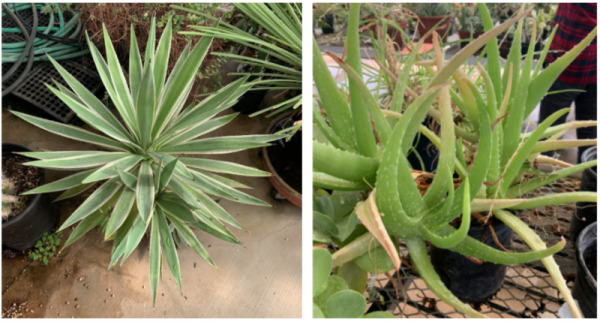By Tatyana Colindres, Erica Barron, James Green, Adrian Sanchez, and Felipe Meraz
Why are different species of desert plants similar?
The desert biome is harsh, with many selective pressures, including low water availability, massive daily temperature fluxes, and high levels of sunlight. These selective pressures drive the evolution of desert adapted traits, including insulation, water retention, and protection. Many unrelated plant groups have independently evolved these desert-adapted traits. This is called convergence: Evolution of similar features occurring independently in distantly related lineages.
Aloe vs. Agave

Agave vivipara (left) and Aloe vera (right)
Agave are in the plant family Asparagaceae, whereas Aloe are in the family Xanthorrhoeaceae. Agave are native to the Southwestern U.S. south through Mexico, whereas Aloe are native to the Mediterranean and Africa. Both genera are widely cultivated, and have been naturalized all over the world. Despite being very disantly related, they share a similar growth pattern, with fleshy, lance-shaped leaves arising from a usually shortend central stem. Agave individuals die after they flower, leaving seeds and "pups" (small plants arising vegetatively from the base). Aloe individuals tend to flower more regularily throughout their lives.

Aloe Vera (left column) and Agave (right column). Top to bottom; Whole leaf, leaf cross-section, 100x cross-section, 400x cross-section.

Euphorbiaceae vs. Cactaceae
Euphorbia are in the family Euphorbiaceae and are mostly native to the Old World, whereas cacti are in the family Cactaceae and are mostly native to the Americas. Both groups of succulent plants are widely cultivated, and take on many forms, adapted to many different habitats. We focus on the stem succulents adapted to desert conditions. Most cacti do not make photosynthetic leaves, and many Euphorbia species either don't or make small leaves that are quickly lost.
(A) Top view of Euphorbia w/ flat brown-colored spines visible. (B) Top view of Cacti w/ small bundled black spines per Glochid. (C) Euphorbia cross section. Center contains a wide circular pith w/ latex pores (defense mechanism). (D) Cataceae cross section. Center contains a small circular pith.
References:
- https://keys.lucidcentral.org/keys/v3/eafrinet/weeds/key/weeds/Media/Htm...(Century_Plant).htm
- https://www.cabi.org/isc/datasheet/4192#tosummaryOfInvasiveness
- https://www.nwf.org/Educational-Resources/Wildlife-Guide/Plants-and-Fung...
- Americangardener. “10 Difference between Agave and Aloe Plants.” AMERICAN GARDENER, 15 Aug. 2021, https://americangardener.net/difference-between-agave-and-aloe-plants/.
Updated: August 08, 2023